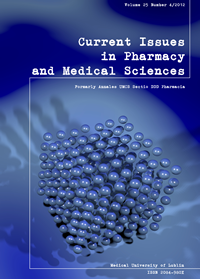The analysis of risk factors for developing shingles
DOI:
https://doi.org/10.12923/j.2084-980X/25.4/a.11Keywords:
shingles, treatment, risk factors, incidenceAbstract
Shingles (herpes zoster) is caused by the reactivation of human herpes virus type 3 (HHV-3) that has been latent in the cranial nerves ganglion and dorsal root ganglion. The purpose of this study was to assess the risk factors for the reactivation of HHV-3, present instructions for the treatment of shingles and describe preventive measures, namely vaccination. The study is based on the analysis of the shingles incidence in patients treated in the Dermatology Department and Dermatology Clinic at The 1st Clinical Military Hospital with Policlinic in years 2007-2011 in Lublin.
The conclusion of the study is that the most important risk factors for herpes zoster are age, co-existing chronic diseases (including cancer) and immunosuppressive therapy. The course of disease in older patients is more severe and requires intensive treatment and hospitalization. In the face of increasing incidence of shingles, the introduction of vaccination against HHV-3 in patients over 50 years of age should be given due consideration in the next 20 years.
References
1. Burgdorf W, H.C. Plewig G., Wolff H. H., Landthaler H. Ludzkie wirusy opryszczki z Dermatologia Braun-Falco, t.1, 88-92, 2010.
2. Cielica W., Sajdak-Wojtaluk A, Chodorowska G., Barczyk A. Przypadek półpaśca uogólnionego i krwotocznego u pacjenta w przebiegu białaczki limfatycznej typu B. Medycyna rodzinna 3, 77-80, 2008.
3. Duszczyk E. Choroby wywołane przez wirusy DNA i RNA. W: Choroby zakaźne i pasożytnicze. Cianciara J., Juszczyk J. (red.) Lublin 515-518, 2007.
4. Dworkin R.H., Johnson R.W., Breuer J., Gnann et al: Recomendations for the management of herpes zoster. Clin. Inf. Dis., 44 (suppl. 1): S1-S6, , 2007.
5. Gros G., Schoffer H., Wassilew S. et al.: Herpes zoster guideline of the German Dermatology Society (DDG), J Clin Virol, 26, 277-89, 2003.
6. Hercegova J., Johnson R.W.: Current management of Herpes Zoster – The European View. Am J Clin Dermatol 6 (5), 317-325, 2006.
7. Madkan VK, Arora A, Babb-Tarbox M, Aboutlabeti S, Tyring S.: Open-label study of valacyclovir 1.5 g twice daily for the treatment of uncomplicated herpes zoster in immunocompetent patients 18 years of age or older. J Cutan Med Surg. May-Jun, 11(3), 89-98, 2007.
8. Majewska A. Dzieciątkowski T., Przybylski M., Łuczak M.: Półpasiec – reaktywacja zakażenia ludzkim herpeswirusem typu 3 (HHV-3). Zakażenia 6(3), 92-97, 2006,
9. McDonald EM, de Kock J, Ram FS: Antivirals for management of herpes zoster including ophthalmicus: a systematic review of high-quality randomized controlled trials. Antivir Ther. 17(2), 255-64, 2012.
10. Mullooly J.P. , Redlinger K. Chun C., Weinmann S., Houston H.: Incidence of hereps zoster 1997-2002. Epidemiol. Infect. 133, 245-253, 2005.
11. Opstelten W., Essen. G, Schellevis F, Verheij T.J.M, Moons K.G.M.: Gender as an independent risk factor for herpes zoster: A Population-Based Prospective Study. Annals of Epidemiology 16 (9), 692–695, 2006.
12. Oxman M.N., Levin M.J., Johnson G.R., et al.: A vaccine to prevent herpes zoster and postherpetic neuralgia in older adults. N. Engl. J. Med. 352, 2271-2284, 2005.
13. Wung P.K. i wsp.: Herpes zoster in immunocompromised patients: incidence, timing, and risk factors. Am J Medicine 118(1416), 9-18, 2005.
14. Zawilińska B. Półpasiec u pacjentów w stanie immunosupresji. Zakażenia 7(1), 97-100, 2007.
15. Żaba R: Epidemiologia zakażeń. W Opryszczka, półpasiec, ospa wietrzna. Żaba R. (red.) Poznań 2011, 72-81.
Downloads
Published
Issue
Section
License
Copyright (c) 2012 Authors

This work is licensed under a Creative Commons Attribution-NonCommercial-NoDerivatives 3.0 Unported License.


